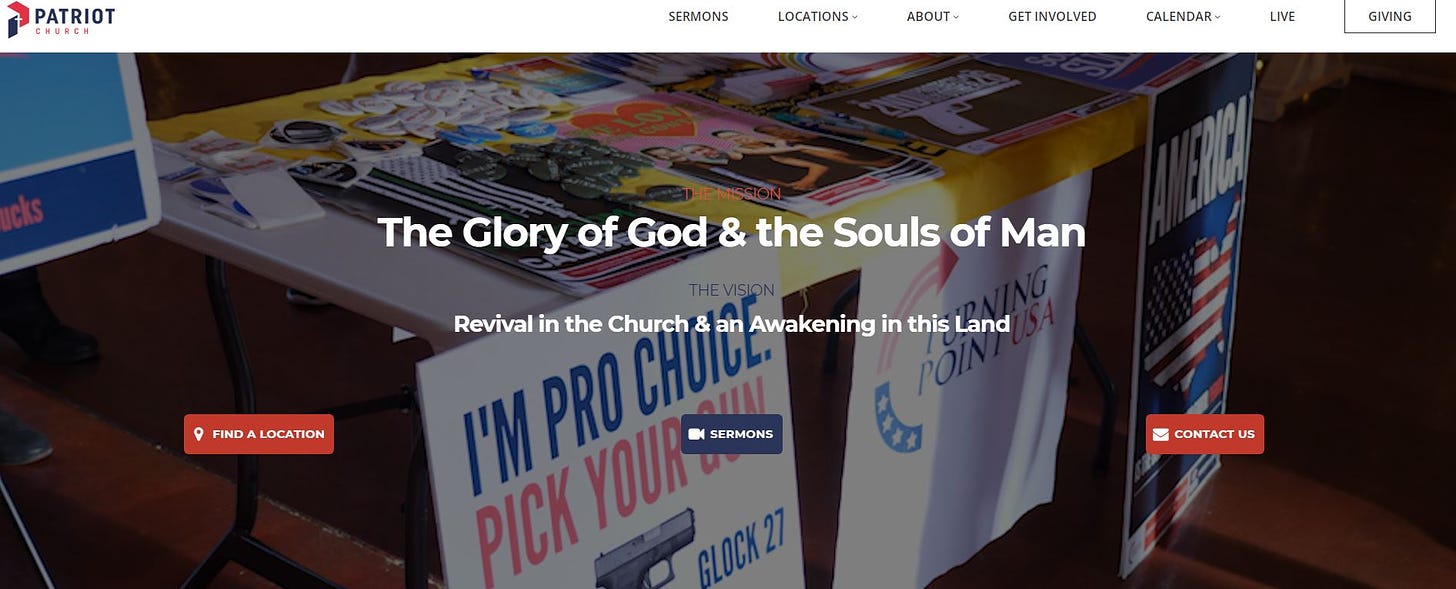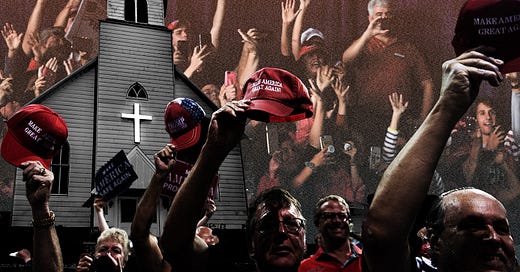
Piety, Patriotism, and Paranoia
What today’s far right looks for in the legacy of the American Revolution.
On a recent Sunday morning out at Moses Lake, Washington, the Patriot Church was praying to change the course of the nation. Among otherwise traditional liturgy, the pastor prayed:
And Lord, we lift up this nation to you. Lord we pray that we as Christians and as Americans would stand up against the tyranny of what is going on. Father help us to not be deceived and to fall trap to the pot-of-boiling-water-with-the-frog syndrome. Lord let us stand up. Lord because this is the freest nation ever Lord that mirrors in so many ways the Kingdom of God in righteousness and holiness. Lord let your Gospel be preached and let revival come. Lord we believe that revival is coming to this land and God we intercede and we come with expectation that you will bring revival. God help us as a nation to repent of our sin, the sin that we lift up and the sin that we celebrate. Lord we pray that our community and the communities around this nation would stand up against the perversion that’s being taught in schools. Lord against all of the critical race theory and all of the identity politics and all of the agenda of the Enemy. God it is not a political issue, Lord, it is a moral issue, it is a family issue, and we ask that you would rebuke the Devourer in the family.
Patriot Church was started last year and now has four locations: in Moses Lake and Spokane, Washington; in Knoxville, Tennessee; and in Lynchburg, Virginia. If you didn’t know anything about the church and were to start by checking out its homepage, the first thing you might notice is the prominence of the red, white, and blue, including in the giant flag painted on the roof of its converted-barn church building in Knoxville.
Within seconds of loading the site, you’ll see the logo of the conservative political group Turning Point USA flash across your screen, and a poster saying “I’m Pro-Choice: Pick Your Gun”:

Poke around the website a little more and you’ll learn that Patriot Church’s “Vision” is “To see revival in the church & an awakening in this land,” and that their list of six “Values” concludes with “The WINNING of our Nation.”
The site also links to the church’s broader coalition, the “Patriot Network,” where their political agenda is set out more explicitly. They see themselves as starting a movement “designed to take back our communities from tyranny . . . through the united actions of politically engaged congregations,” because “our country is under attack by demonic principalities and powers.” The page cites Roe v. Wade, critical race theory, the 1619 Project, public health measures. It ends by linking its aims to those of the Founders:
Of the 56 signers of the Declaration of Independence, 29 were ordained ministers. Many of these patriots were members of the Black Robe Regiment (pastors wore black robes in the pulpit). They led their congregations in the American Revolution. It is now our turn to preserve what they so bravely fought to create. NOT violently, but peacefully by leveraging our vote and influence.
This is the crux of the church’s distinctive political theology: We are living through a new American Revolution, and as in the old, devout and patriotic congregations must lead the way into spiritual and political battle.
This understanding of the Revolution may feel foreign. The American mythic lens most of us are accustomed to is more secular—we tend to glorify the generals, the Minutemen, the statesmen afterwards. But both are based in truth. The Revolution, as an event, contains multitudes, and while the revolutionaries were united into a coalition by their opposition to the Crown, they were motivated by differing ideologies.
Patriot Church is just one example of a contemporary phenomenon in which Americans find in the Revolution support for anti-government activity. Much more famous are the militias, which draw on the militant legacy and anti-government rhetoric of the Revolution to justify their anti-government activity. The Oath Keepers, for instance, one of the groups allegedly implicated in the January 6 Capitol riot, have adopted symbolism and rhetoric from revolution—calling themselves patriots and minutemen, and holding their first rally at the site of the Revolution’s first battle. Their leader, Stewart Rhodes, recently released a statement telling members to:
follow the Founders’ game plan, using their strategies and methods, which focused first on declarations of illegitimacy, nullification (declaring unconstitutional acts to be null and void from inception, and refusing to obey them), unified mass non-compliance with unconstitutional and oppressive actions and then on self defense, mutual defense, and resistance when the domestic enemies of the Constitution come for us. That’s how the Founders did it, and it worked. There is nothing new under the sun.
Another group reportedly implicated in the Jan. 6 riot, the Three Percenters, recently put on the terror list in Canada, are even more explicit in claiming the mantle of the Revolution. The group’s name, in fact, comes from the inaccurate notion that only 3 percent of Americans fought in the Revolutionary War. And QAnon, the loose-knit, rapidly evolving network of conspiracy theorists, even as it maintains aspects of its core identity, is working on rebranding itself as “Patriots.”
As much as we might like to think that these invocations of Revolutionary identity are a misappropriation, the truth is there is plenty of precedent in early American history for the disturbing ideas, intentions, and modes of thought seen on the far right today.
Take QAnon, for example. Conspiratorial notions of hidden, malevolent oppositional forces were a common theme of early American thought, often constituting an overt component of political and social thought. Early Americans frequently resorted to conspiracy theories to explain much of their rapidly changing world. Disobedient children or troublesome neighbors were proof of witchcraft and Satanism. Imperial rivalry with Catholic France, and the conflicts that inevitably followed, were taken as proof of a Catholic cabal set on enslaving Protestant Britons around the world. Even comparatively minor imperial reforms imposed by the British on their colonies would eventually be seen as sufficient evidence of an attempt to enslave and oppress the long-suffering early American of the mid-eighteenth century. Laugh if you will at QAnon, but the power of the hysterical and fantastic to explain reality has always appealed to the American mind in times of upheaval or crisis. The society that would, after the Revolution, erect a secular state stylized on the Enlightenment is the same society in which it was widely believed in the 1770s that British efforts to send a single Anglican bishop to the colonies was the start of an elaborate plan to impose Catholicism and slavery on American society. Indeed, the two facts are likely inseparable: The religious fears informed the creation of safeguards protecting the state and religion from one another.
Meanwhile, Patriot Church believers are right to believe that religious leaders of the revolutionary era played an outsized role in the violent resistance to British rule. Throughout the 1760s and ’70s, priests and pastors around the American colonies preached sermons advocating resistance to tyrants, the limits of legal submission, and the Christian duty to resist. These messages were widely published and consumed, and both British and American audiences clearly understood the political messages contained therein. Minister Abraham Keteltas of Massachusetts declared the revolution the cause of God and the struggle against the British as one of “heaven versus hell.” As Alan Heimert, Carl Bridenbaugh, and many other historians have shown, it was more than anything else the rhetoric and meaning provided by religious belief that eventually convinced Americans that violent resistance was not only necessary, but an exercise in piety.
The connection between religious leaders and the revolution extended even to the very infrastructure of American life. In many communities, the minister served as militia muster officer, sometimes even within the militia itself. Peter Muhlenberg, a Virginia minister, famously threw off his robes at the end of a sermon to reveal his militia officer’s uniform and commanded his flock to enlist to fight the forces of Satan. Many pastors recruited openly from their weekly sermons before the assembled community. Pro-Patriot ministers took full advantage of the fact that churches were one of the last sources of information—and misinformation and disinformation—to be censored by British military authorities once fighting broke out. Ministers gave misleading news reports on American troop movements for British ears, they dispatched coded messages, and they invented atrocities supposedly committed by British occupying forces with the aim of provoking American responses.
The term mentioned on the Patriot Church website, “Black-Robed Regiment,” is based on a pejorative and accusatory label (“black Regiment”) applied to American ministers by some frustrated British officials. The fact that the term “Black-Robed Regiment” has been proudly picked up by today’s American reactionaries—not just by Patriot Church, but by others on the right—is, as we wrote in the Washington Post last week, “not passive historical cosplay” but “advocacy for insurrection.”
Was the American Revolution dominated by extremists, fanatics, and zealots? No. For a not insignificant number of Americans in the revolutionary era, paranoid explanations were sincerely considered plausible explanations for confusing and chaotic experiences. But for most participants in the Revolution, the common cause made with these extreme elements was a matter of political expediency, and it ended with the Revolution itself. Ultimately, this alliance would forge a new country.
But that new country was—and remains—an uneasy alliance of wayfarers and believers. In 1798, Rev. G.W. Snyder wrote to George Washington, sending him a book published that year in Philadelphia by John Robinson entitled Proofs of a Conspiracy Against All the Religions and Governments of Europe, which remained in Washington’s library from then on. Snyder wrote letter after letter to Washington, trying to convince him that the book proved that Freemasons were spreading the toxic ideology of the Illuminati in America—and Washington eventually responded that while he had not had time to read the book that he did not believe there was an organized conspiracy. This ended the matter; the former president had other concerns on which to spend the last year of his life. But it is the legacy of those like G.W. Snyder, conspiratorial thinkers, paranoid pesterers of public officials—the legacy of Muhlenberg, leading the church into battle—the legacy of Keteltas, making politics into apocalyptic warfare—that today’s so-called “Patriot” churches and militias want to resurrect in our modern day.











